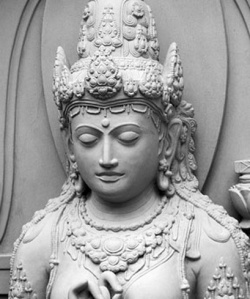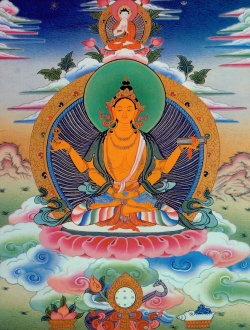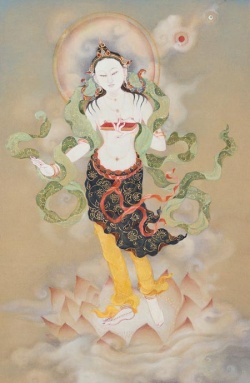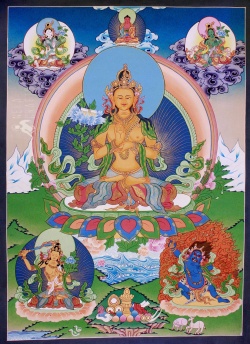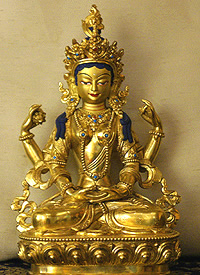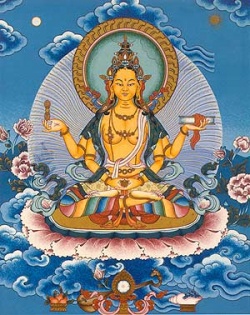Perfection of Wisdom
Talk six of six on the Buddhist Wisdom teachings
“Call forth as much as you can of love, of respect and of faith! Remove the obstructing defilements and clear away all your taints! Listen to the Perfect Wisdom of the gentle Buddhas, Taught for the weal of the world, for heroic spirits intended!”
This is how the teaching of the Ratnagunasamchayagatha begins. The Ratnagunasamchayagatha is one of about 35 Perfection of Wisdom texts. This verse is important because it tells us how we should approach the whole topic of Perfect Wisdom, in fact, how we should approach the Dharma. It asks us to cultivate receptivity and to purify ourselves. This applies when we are engaging in study,
reading, discussion or listening to talks. “Call forth as much as you can of love, of respect and of faith!” The love, respect and faith are already there, you just need to contact them and bring them to bear in the situation. You already love the Dharma, you already respect its profundity, and you already have faith in its effectiveness. That is why you are practising,
that is why you are reading this. You need to contact “as much as you can” of that love, respect and faith. This is what constitutes your receptivity. When you are receptive you can gain much more than when you are in a state of doubt or cynicism. So, the first thing is to be as receptive as possible. Open your heart to the Dharma. What you are really calling forth is positive
emotion. You don’t need to be a scholar, you don’t need to have a master’s degree, you don’t need to be highly intelligent, you don’t even need to be literate. But you do need to have sufficient positive emotion to listen to the
Dharma. Your heart needs to be open enough to allow the Dharma to enter. For this to happen, you need to purify yourself of unskilful mental states. If you are in a state of ill will or anger or neurotic craving, you need to at least be aware of it and if possible put it to one side while engaging with the Dharma teaching.
Even better is to prepare yourself before studying or listening to a talk or reading a text by meditating and endeavoring to transform any negative emotions. When you are prepared, then you can “listen to the Perfect Wisdom of the gentle Buddhas”. You can really listen, that is not just with your ears but also with your heart. This is the advice of the “gentle Buddhas”, the
Compassionate Buddhas who want to help you to overcome all suffering. They teach the Dharma, “for the weal of the world”. And finally, the verse says this Perfect Wisdom is “for heroic spirits intended”. The Dharma changes people, it affects every
aspect of your life, no corner is left untouched. This can be a frightening prospect, it can make us feel insecure. Is there not something we can hold on to? Something that can stay unchanged? No, there isn’t. And that’s why we need courage to really listen to and
engage with the Dharma. We have to be prepared for anything to happen. We have to be prepared to make unpalatable discoveries about ourselves, we have to be prepared to have our most cherished views and opinions challenged and shattered, we have to be prepared to live by values that the world may ridicule, we have to be prepared to upset people by not living our lives as they want us
to, we have to be prepared for radical change in every area of our lives, we have to be prepared for the ego destroying explosion of Perfect Wisdom. This is why the Dharma is “for heroic spirits intended”.
What is the Perfection of Wisdom? Well, on one level it is a whole body of literature comprising, as I said, about 35 texts. Perhaps the most well-known Prajnaparamita texts are the Heart Sutra and the Diamond Sutra. There is also the Perfection of Wisdom in 8,000 lines, which is rendered into verse as the Ratnagunasamcayagatha from which I quoted at the beginning. There are other
texts ranging from the Perfection of Wisdom in 100,000 lines to the Perfection of Wisdom in one letter. This Prajnaparamita or Perfection of Wisdom literature has all been translated into English due to the efforts of one man, the great scholar Dr. Edward Conze. The main characteristic of the Prajnaparamita literature is that is totally non-
rational. It consists of paradox after paradox and is most frustrating to the rational mind. And this is its intention. It is an all-out attack on literalism. It sets out to destroy all conceptualization and to thwart the rational mind at every turn. The rational mind will get angry with the Perfection of Wisdom or dismiss it as rubbish. This is another
reason why we need to “call forth as much as we can of love, of respect and of faith”. The Diamond Sutra was the first ever printed book, printed in China. It seems fitting that the first text put into print should be the highest
teaching known to mankind. It was on hearing the Diamond Sutra being recited in the market place that Hui Neng gained Enlightenment. Hui Neng became the sixth patriarch of the Zen or Chan tradition. He was an illiterate young
man at the time but the Diamond Sutra awakened him to the nature of Reality. And it was the Diamond Sutra and the Sutra of Hui Neng which Sangharakshita read at the age of 16. And he too experienced an awakening.
He says, “…..when I read the Diamond Sutra I knew that I was a Buddhist. Though this book epitomizes teaching of such rarefied sublimity that even Arahants are said to become confused and afraid when they hear it for the first time, I at once
joyfully embraced it with an unqualified acceptance and assent. To me, the Diamond Sutra was not new. I had known it and believed it and realized it ages before and the reading of the Sutra as it awoke me to the existence of something I had forgotten.” (Learning to Walk, p 118) So, we in the WBO and FWBO can be very grateful to the Perfection of Wisdom and especially to the
Diamond Sutra. Our whole Order and Movement is a part of the unfolding of that Realisation Sangharakshita had at the age of 16. We are spiritual children of the Perfection of Wisdom. The Heart Sutra contains the essence of the Prajnaparamita teachings. That is why it’s called the ‘Heart’ Sutra, it is the heart of the Prajnaparamita. The [[Heart
Sutra]] is a teaching on Shunyata, it expresses an Insight into Shunyata. That is in fact what the whole Prajnaparamita literature is about. It is all about Shunyata. Sangharakshita, in his commentary on the Heart Sutra, has said that the Sutra consists essentially of six statements. So we will look at these briefly. The Heart Sutra is the dialogue between the Bodhisattva Avalokitesvara and Sariputra. Avalokitesvara is, of course, the Bodhisattva of Compassion, so we
might wonder why he turns up here to deliver the heart of the Perfection of Wisdom teachings. And that is an opportunity for us to reflect yet again on the essential unity of Wisdom and Compassion.
Sariputra was one of the chief disciples of the historical Buddha. He was noted for his wisdom. In the later sutras, the
Mahayana sutras, Sariputra is often made to represent the degeneration and rigidity of scholastic Buddhism. So here he represents a lesser kind of wisdom, intellectual wisdom or literalistic wisdom and Avalokitesvara represents the Wisdom of the Enlightened mind, the Wisdom of direct experience of Reality. In this conversation, Sariputra, the lesser wisdom, does not say anything. In the face of the Wisdom of the Awakened mind, all lower wisdom is rendered mute.
In the Heart Sutra, Avalokitesvara makes six statements. The first statement is that the five skandhas are empty. The five skandhas are the basic constituents of all existence, whether things or people, and this statement is saying that there is nothing else behind or Beyond them, no soul or self. Everything is included in the five skandhas, material form, feelings, perceptions, volitions and consciousness. There is nothing else in
the universe apart from these, nothing independent of them and hey are empty of any ‘self’ or ‘soul’. The second statement is that all Dharmas are empty. This needs some explanation. The Abhidharma tradition of Buddhism, which is the more intellectual, analytic tradition, compiled a huge and complex classification of all existence, breaking everything
down into ever smaller units and eventually they arrived at what they thought of as the basic units of existence, the irreducible elements, that couldn’t be broken down any further. These units or elements they called dharmas.
So when Avalokitesvara says all dharmas are empty, he is dismissing this whole vast compilation, as a delusion; a very subtle delusion but a delusion nevertheless. He is saying it is not possible to give a systematic philosophic o
r scientific account of Reality. Reality is beyond and above any ideas about Reality. In our poetic version of the Heart Sutra, this statement is rendered as “All things are the primal void”. The third statement of Avalokitesvara is that in Shunyata no dharmas exist. This reiterates what has already been said in a slightly different form. It is saying that
Reality is devoid of concepts and ideas. Reality is something other than anything we say or think about it. The fourth statement in the Sutra takes various categories of Buddhist thought, various lists, and so on and says there is nothing ultimately valid about them. This is again similar to the last two statements.
It is saying that all ideas, even Buddhist ideas are not Reality. They are not ends in themselves. The Dharma is a raft to cross to the other shore or a finger pointing at the moon. What the other shore is or what the moon is, is another matter and cannot be squeezed into any categories or lists. The fifth statement says that one becomes a Buddha by relying on Perfect Wisdom, in
other words, by having a direct experience of ultimate Reality. The sixth and last statement makes this same point even more strongly by saying that all Buddhas, past, present and future gain Enlightenment through the development of Perfect Wisdom. And the Sutra ends with the Perfection of Wisdom mantra –gate gate paragate parasamgate
bodhi svaha. This mantra is related to the four levels of Shunyata. The mantra is translated by Dr. Conze as meaning, “Gone, Gone, Gone beyond, Gone altogether beyond, O what an awakening, all hail”. So, let us look at the four levels of Shunyata. The first ‘gate’ refers to the first level of Shunyata, which is called samskrta sunyata. Samskrta
means ‘compounded’ or ‘confected’ or simply ‘put together’. So, samskrta sunyata means the emptiness of the compounded. Compounded existence is unenlightened existence, also known as Samsara. So this level of sunyata is saying that
unenlightened existence is empty of the characteristics of Enlightened existence. The characteristics of Enlightened existence are happiness, permanence and ultimate Reality. Compounded or unenlightened existence is empty of these. It is unsatisfactory, impermanent and insubstantial.
This level of sunyata says that Samsara is empty of Nirvana and we cannot find in unenlightened existence what only Enlightenment can give us. The second level of sunyata is called asamskrta sunyata. This is the emptiness of the
Uncompounded. This is the emptiness of Enlightened existence or of Nirvana. This is the same as the previous point except from the other side so to speak. It is saying that Nirvana is empty of Samsara, Enlightened existence is empty of the characteristics of unenlightened existence. There is no suffering, no impermanence and no unreality in Enlightened existence. The third level of sunyata is maha sunyata or ‘great emptiness’. This is the emptiness of
any distinction between unenlightened existence and Enlightened existence. It is saying there is just one Reality, not two realities. This means that all dualities between Enlightened and unenlightened, Samsara and Nirvana are provisional and pragmatic but not ultimate. The fourth level of sunyata is sunyata sunyata, the emptiness of emptiness.
This is saying that emptiness itself is only a concept. Sunyata is a concept, a word that is pointing to something, is hinting at something, but it is not the experience itself. The experience cannot be described, it is beyond the reach of language. All that is left is silence, perhaps even a ‘thunderous silence’ like that of Vimalakirti in the
Vimalakirti Nirdesa. As Sangharakshita puts it in What is the Dharma, “One may be as eloquent and insightful as one likes, but shunyata will always remain ultimately a mystery, even the greatest of all mysteries, so far as the Buddha’s teaching is concerned. It cannot be explained or even described”. After all the words we have silence. After all the talk of Shunyata, shunyata disappears like a bubble.
The Perfection of Wisdom literature is all about sunyata and it is full of paradox. Prajnaparamita cannot be packaged up in words and concepts and perhaps that’s why Prajnaparamita developed into a goddess, a
Bodhisattva in female form. But before we can go on to talk about the Bodhisattva Prajnaparamita, let us just draw a few lessons from the different levels of sunyata. The first two levels of sunyata make a clear distinction between Samsara and Nirvana, unenlightened existence and Enlightened existence. And this is very necessary. We need to make this
distinction, we need to think in this way for practical reasons. If unenlightened existence is here and Enlightenment is over there, then we have to get from one to the other. And to get from one to the other we need to take certain steps, we need to do certain things. We need to progress from here to there, from Samsara to Nirvana.
This is quite pragmatic and quite necessary, at least until such time as we have more direct insight into Reality. The danger with this is that we may become overly goal-orientated and begin to think of Nirvana as something to get to without actually changing ourselves. The pursuit of Nirvana or spiritual bliss could become a substitute for real spiritual practice.
Real spiritual practice involves greater and greater awareness of ourselves and the rest of existence. We need to become deeply aware of our motivations, even our motivation for spiritual practice. We need to become deeply aware of the subtleties and nuances of our responses to other people and our responses to events. We need to become deeply
aware of the effect we have on the world and the effect the world has on us. We need to constantly probe deeper and develop more and more awareness. In doing this we are actually approaching nearer to Reality but we are not chasing after Reality as if it were something completely external to our life. This is what the third level of sunyata is telling us.
Nirvana is to be found in Samsara. Unenlightened existence and Enlightened existence inhabit the same Reality. As the Song of Meditation says, “apart from water, no ice, outside living beings, no Buddhas.” The fourth level of sunyata is warning us against the dangers of literalism. The tendency of our rational minds is to grasp concepts and fix them. And the Perfection of Wisdom literature is, as it were, on a crusade against literalism. So we arrive at the
emptiness of emptiness and silence. But when the words run out an image arises. It is the image of a mature woman, golden yellow in colour, wearing a tiara with jewels of five colours. She is seated in full lotus posture on a white moon mat, in the center of a blue lotus. Her hands are in the mudra of teaching. She holds the stem of a lotus in
each hand and the lotuses open into blossoms, one at each shoulder. Resting on each lotus is a volume of the Perfection of Wisdom. This is the Bodhisattva Prajnaparamita. There are other forms of Prajnaparamita. Sometimes she is white and sometimes she has four or six or even eleven arms. She may also have a vajra, a sword, a mala and a begging bowl. The mantra
associated with Prajnaparamita, as described above is different from the mantra at the end of the Heart Sutra, although that mantra is also sometimes associated with the visualised figure. This mantra is ‘om ah dhih hum svaha’ and it cannot be translated into any conceptual form. It is simply a sound symbol of the Perfection of Wisdom. This is what
Vessantara says about meditation on the Bodhisattva Prajnaparamita, whom he refers to as a goddess. “Regularly performing a sadhana of Prajnaparamita produces an ever deepening involvement with the Wisdom goddess. To start with the goddess becomes a focus for devotion.
For men, her practice can often absorb the romantic and other feelings that might be evoked by meeting a beautiful, mature woman. For women, she is often a figure with which to identify, the most positive of all role models. Thus for both sexes energy can easily be engaged by the meditation, and hence poured into the contemplation of Wisdom. If this process continues, the practice enters
the realm of the archetypal. In Jungian terms, a man may project the highest aspect of his anima, whilst a woman may encounter the Magna Mater. She becomes for the meditator the archetypal Wisdom goddess – found in many traditions. For the Gnostics she was Sophia, for the Greeks Athena. She is found in the Tarot as the High Priestess, wearing a headdress of the crescent moon, and holding a scroll – corresponding to the book of
Prajnaparamita. Prajnaparamita is the Wisdom goddess of India – once described as staggeringly beautiful to the point of being scorching. Her meditation can become a way of experiencing the archetypal beauty of the refined levels of one’s mind. Finally, with faithful practice, she can become far more than that. She can become the experience of [[transcendental
wisdom]] itself – the transcendence of the world of subject and object.” (Meeting the Buddhas, p 227) Before we finish I want to repeat two points that have come up many times. Firstly, Perfect Wisdom or Enlightenment is not a rational experience.
It is not a matter of gaining knowledge or getting our ideas right. It is something else altogether. It is a direct face-to-face experience with Prajnaparamita and awareness is the key to unlock the mysteries of this experience. Secondly, Wisdom and Compassion are not different. When Perfect Wisdom acts the activity is Compassionate. When Perfect Wisdom
speaks the words are Compassionate. It cannot be otherwise However, to come back to the level of day-to-day practice, I think there are two things we can usefully do in order to develop Wisdom and Compassion. The first thing is not to identify with our moods. Our moods are passing things and to develop Insight into the self as a process of change we need to let go of identifying with moods and not take our ups and downs too seriously – not take our centrality in the universe too seriously. In this way we can gradually
develop wisdom. The second thing we can do is to practice generosity. This is the most basic spiritual practice and it is the beginnings of Compassion. We need to practice generosity in the small things in order to cultivate the mind of compassion, which is concerned with the spiritual welfare of all. We have now come to the end of this exploration of Wisdom.
We began by looking at Wrong View, Right View and Perfect Vision. Then we went on to explore different ways of attaining Insight. We looked at the stages of the Eightfold Path and the three levels of Wisdom. We took in different perspectives on Realisation, including Stream Entry, Turning about in the Deepest Seat of Consciousness, the Arising of the Bodhicitta and Real Going For Refuge. Then we widened our horizons to take in a view of the four Viparyasas or
topsy-turvy views, the 3 marks of unenlightened existence, the 3 liberations and the Bodhisattvas known as the family Protectors. We explored the five wisdoms associated with the Mandala of the 5 Buddhas and now we have just been looking at the Perfection of Wisdom, the Heart Sutra, the four levels of Shunyata and the Bodhisattva goddess Prajnaparamita. We have covered a lot of ground and some of it very quickly indeed. I hope we have gained something from the journey if only a desire to revisit some of the sights.

